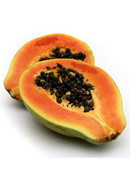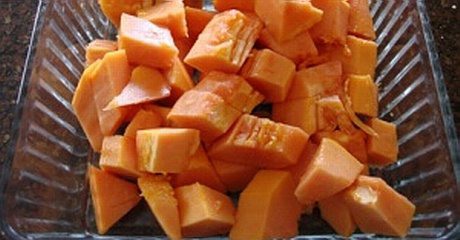 The operations involved in the processing of fresh-cut products induce a rapid enzymatic depletion of natural antioxidants as a response to the cutting. For example, the retention of ascorbic acid depends on tissue integrity, the respiration rate increases in cut tissues causing a faster quality decay of the fresh-cut product.
The operations involved in the processing of fresh-cut products induce a rapid enzymatic depletion of natural antioxidants as a response to the cutting. For example, the retention of ascorbic acid depends on tissue integrity, the respiration rate increases in cut tissues causing a faster quality decay of the fresh-cut product.Fresh-cut tropical fruits, including papaya, were found to be of unacceptable quality after only 2 days of storage at 4°C, mainly due to the tissue softening. In recent years, the many technical problems involved in maintaining the quality and the microbial safety have limited the use of fresh-cut papaya in food service institutions.
Many studies have determined the effects of maturity stage, cutting shape, storage conditions, and modified atmosphere on quality and shelf-life of fresh-cut papaya. The objective of the work conducted by Argañosa et al. (2008) on fresh-cut papaya was to determine the effects of different cut-type (cube, parallelepiped, cylinder, and sphere) on the quality and shelf-life of papaya ‘Sunrise Solo’ stored at 4°C for 10 days.

For the experiments, papayas grown and harvested in Brazil were imported (air-freight) into Portugal at Escola Superior de Biotecnologia da Universidade Catòlica Portuguesa. The fruits were stored at 20°C and 50% RH before processing, which occurs 5 days after harvesting.
Then they were washed and sanitized with chlorinated water, peeled, de-seeded, cut into different shapes, and placed in rigid plastic containers. Physicochemical (colour, firmness, pH, titratable acidity, total soluble solids, weight loss, L-ascorbic acid), microbial (faecal coliforms, total microorganisms, lactic acid bacteria, yeasts, and moulds), and sensorial (global appreciation, general appearance, odor, texture, and flavor) were performed on the different papaya cut-types during storage.
The results of physicochemical, microbial, and sensorial analyses performed on the different papaya cut-types indicated an acceptable fresh-cut product during the storage at 4°C for up to 10 days.
Papaya spheres showed the lowest losses of texture and weight, while cubes presented the highest losses. After 10 days of storage, the firmness of papaya spheres decreased significantly by 35%, cylinders by 41%, parallelepiped by 48%, and cubes by 58%. Papaya cubes showed the highest (11%) and the sphere the lowest (7%) weight loss.
Significant increases in pH value for all papaya cut-types were measured after 10 days of storage. The lowest pH increase was 1.3% for spheres and the highest (5.2%) for the cubes. Low pH is preferred in fresh-cut fruits because it allows to control better the microbial growth. In agreement with the pH results, titratable acidity decreased significantly during storage, the highest decrease was 12% in papaya cubes.
The microbial safety was maintained during storage in all cut-types, this result has shown the efficacy of the sanitation of whole fruit before processing combined with low temperature (4°C) after processing to guarantee the fresh-cut product safety. As regards sensorial analyses, papaya spheres received the highest score for global appreciation after 8 days of storage.
This study has shown that the fresh-cut papaya stored at 4 °C can reach a shelf-life of 10 days.
Original study. Argañosa ACSJ, Raposo MFJ, Teixeira PCM, Morais AMMB, "Effect of cut type on quality of minimally processed papaya", 2008. For more details:
repositorio.ucp.pt/bitstream/10400.14/2780/3/Effect%20of%20cut-type%20on%20quality%20of%20minimally%20processed%20papaya.pdf








